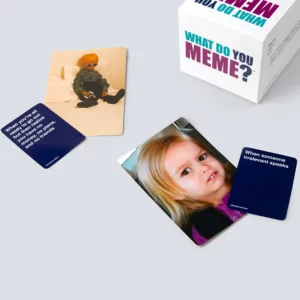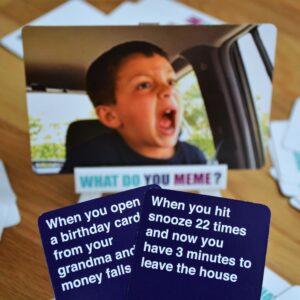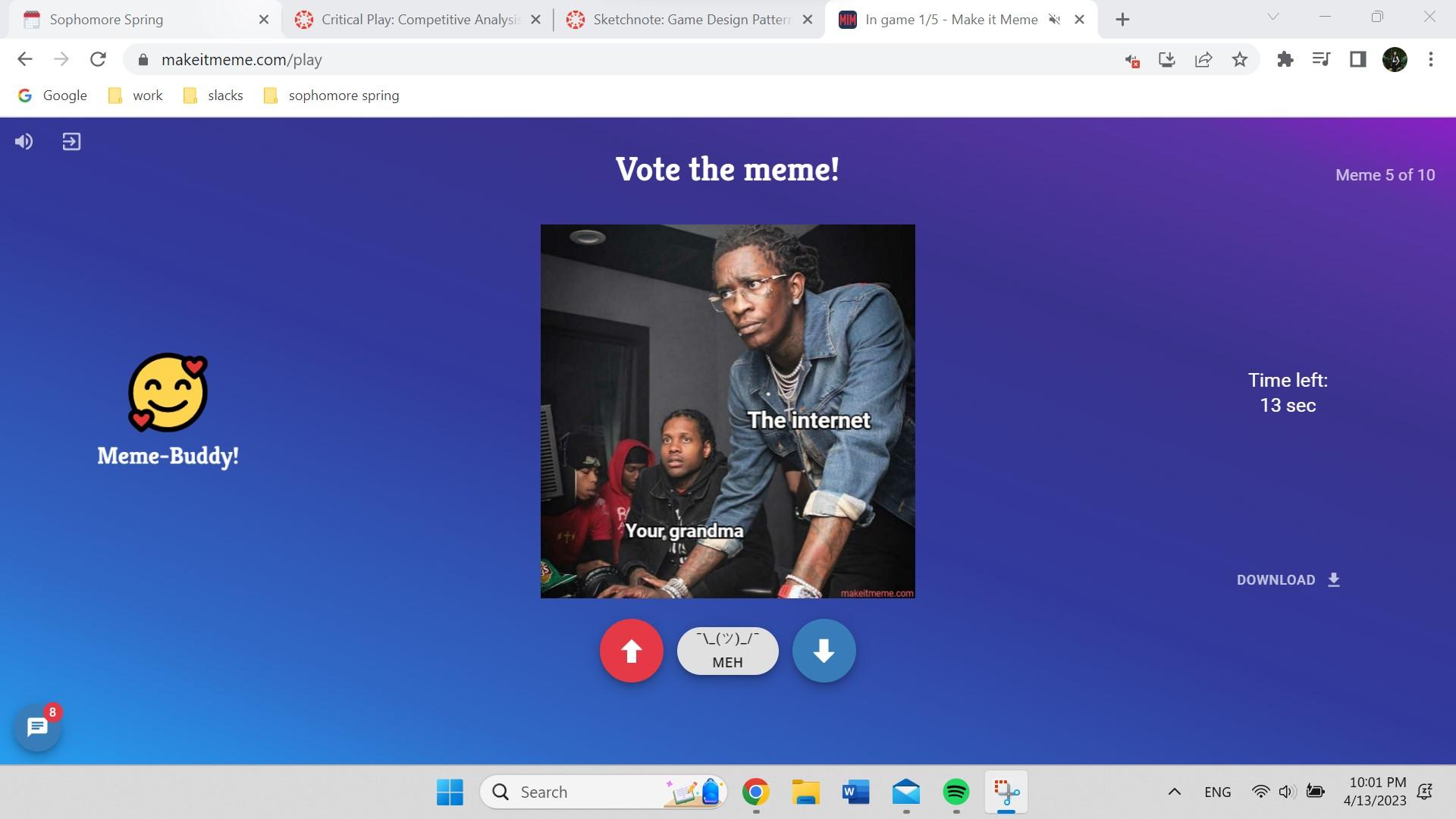I ended up with What Do You Meme? at a White Rabbit last Christmas (along with a candle)! I’m so glad I get to bring/contribute something other than Cards Against Humanity at parties now.

The theme of What Do You Meme? is humor and pop culture references. Players take turns captioning a meme photo with a caption card from their hand, and the judge picks the funniest one.
The different formal elements of What Do You Meme? include the cards, the memes, the caption cards, and the voting chips. The cards and memes are the game’s primary components, and they serve as the foundation for the players’ creativity. The caption cards are the players’ tools to create funny captions for the memes, and the voting chips are used to determine the winning caption. These formal elements interact with each other to create a dynamic and entertaining game experience.
In terms of mechanics, What Do You Meme? makes use of a simple matching mechanic: players must match a caption card with a picture card to create a meme. It also uses a voting mechanic: players vote on the best meme created by the other players. The mechanics of What Do You Meme? may be simple and straightforward, but they contribute significantly to the game’s dynamics and aesthetics. For example, the voting mechanic in What Do You Meme? is crucial to the game’s dynamics and aesthetics, creating a competitive atmosphere that encourages players to be creative and witty with their captions. It also incentivizes players to choose the funniest caption rather than their own, which encourages cooperation and social interaction. The game’s aesthetics are enhanced by the humor and laughter that come from the players’ witty captions.
The kind of fun that What Do You Meme? promises the player is that of fellowship, as it encourages players to be creative and funny while interacting with each other. It also promises to be a lighthearted and entertaining game that is easy to learn and play.
I find that the graphic design of What Do You Meme? is important in reinforcing its theme and fun factor. The picture cards feature well-known memes and pop culture references, which are instantly recognizable and add to the game’s humor. The caption cards also feature funny and irreverent phrases, which add to the game’s overall tone. The design of the cards is also simple and colorful, which makes them easy to read and use during gameplay, and the game’s design is visually appealing as well as well-organized, with clear instructions and a sturdy box for storage.

What Do You Meme? differentiates itself from other popular party/judging games by focusing solely on creating memes and internet culture, appealing to an audience that appreciates this contemporary form of humor. It also allows for a lot of creativity and variation, as players can come up with their own unique memes based on the cards they are dealt. While games like Cards Against Humanity and Apples to Apples also involve captioning and judging, they don’t quite have the same cultural relevance as What Do You Meme?. Additionally, the voting mechanic in What Do You Meme? is more dynamic and interactive than other judging games, which can sometimes feel repetitive and dull.
As aforementioned, it is a game that relies heavily on humor and pop culture references, so it is best suited to be played by people who are familiar with internet memes and current events. One of the strengths of the game is its ability to generate laughter and create a fun atmosphere for players. The game mechanics are simple and easy to understand, making it accessible to a wide range of players.
However, there are a few flaws in the game that may impact the overall experience for some players. The reliance on pop culture references may make the game less enjoyable for those who are not familiar with internet memes or current events. Additionally, the game’s humor can be crude or offensive at times.
On that note, What Do You Meme? does not have any specific policies or guidelines for handling abuse or offensive behavior during gameplay, which is one drawback. However, the game does come with a warning that it is not intended for children and that some content may be offensive. Players are encouraged to use their own discretion when playing the game and to not use it to promote hate or discrimination. While the game is meant to be lighthearted and humorous, it can also be offensive or hurtful if players use it to make fun of certain groups or individuals. To make the game safer for players, guidelines could be added to discourage inappropriate or offensive captions. Another approach would be to create a system of moderated content, where offensive or inappropriate captions/cards could be removed or modified by moderators. This would help to ensure that the game remains fun and engaging without crossing the line into offensive or hurtful territory. The game could also incorporate trigger warnings for sensitive topics (such as mental health issues). This would give players the opportunity to opt-out of certain cards or topics if they feel uncomfortable.

To improve the game, I would recommend including more diverse and inclusive content in the game, to ensure that all players feel welcome and represented. Furthermore, the creators could consider incorporating a wider range of references, including historical events or classic movies, to make the game more accessible to a broader audience. The game could also benefit from the addition of more creative challenges or game modes to keep the gameplay fresh and exciting!



